|
|
|
Hansen's Northwest Native Plant Database |
|
|
|
Prunus emarginata
(Bitter Cherry)
|
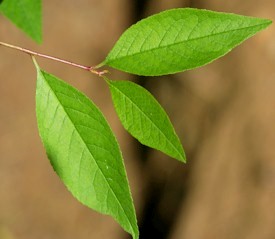 |
||||||||||||||||||||||||||||||
|
Plant Brief: This attractive tree is sure to bring the birds to your yard! It is native from BC, south to California, east to New Mexico and Montana, in USDA zones 4-8. It is found in riparian areas at low to middle elevations and also an important species to pioneer after logging. Bitter Cherry is a lovely tree, reaching 20-50, with thin, dark reddish brown bark. Leaves are 1-2 oval with tiny serrations. The highly decorative flowers are in 4-6 posies of no more than ten. The red, juicy, fruit is too bitter for eating and seeds contain cyanide but the birds devour them without affect! This species thrives in loamy soil in sun or partial shade. Native groups peeled the strong bark from trunks to use in basketry and tool making. |
|||||||||||||||||||||||||||||||
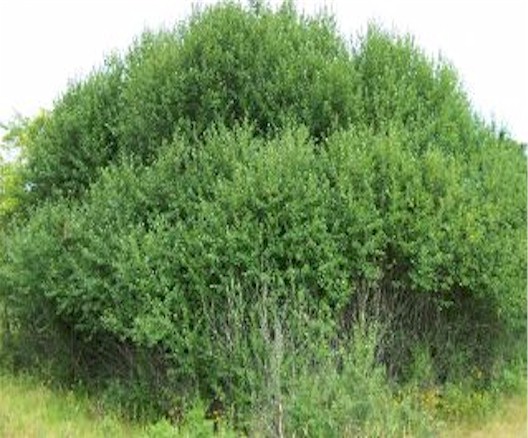 |
Description: Bitter Cherry is small, broad-leaved, deciduous and can be anywhere from shrub size to a 42' tree, with thin, shiny red bark and scattered white spots on the young twigs. The main trunk is smooth, dark reddish brown, while branches and smaller trunks are silvery.
Leaves are simple, alternate, deciduous; oblong to oval,
from 1 to 3 inches long, dark green above and paler below, serrated margins,
small glands on basal serrations or petiole. |
||||||||||||||||||||||||||||||
|
Uses of Plant: Indians of British Columbia and Washington used bitter cherry medicinally and for making tools. Fruits were used as laxatives, and the roots and inner bark were boiled and ingested to prevent heart trouble. The bark of Bitter Cherry peels off in long fibrous strips which were used to make baskets and other implements. |
|||||||||||||||||||||||||||||||
|
Bitter Cherry can be a sizable tree on
the coast, at lower elevations, but is often shrubby at higher elevations and in
the interior. The flowers are in short racemes, red dupes are visible by
mid-summer. Birds actually eat these though they are very short. And in winter,
Gross Beaks come through and crack the pits to extract the seed. |
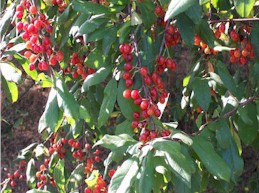 |
||||||||||||||||||||||||||||||
|
Downed trees become an important habitat for insects, amphibians, and small mammals as the bark is very resistant to decay. The result is that the bark persists while the internal wood decays and provides housing space for these wee beasties! Bitter Cherry is planted as an ornamental, very attractive in the landscape. |
|||||||||||||||||||||||||||||||
|
Native
Plant Gardening/Wildlife Habitat:
An excellent backyard habitat plant, providing essential food, shelter,
and nesting sites for a wide variety of wildlife. Bitter Cherry is a valuable
forage species for mule deer, elk, and black bear. In the Pacific northwest and
California, Bitter Cherry is highly preferred winter forage for Columbian
black-tailed deer. In the southwest, Bitter Cherry is browsed by deer and elk. Bitter Cherry is highly palatable to sheep. In fact it is a preferred sheep food in Oregon. Bitter Cherry is also eaten by cattle. Propagation: To sprout the seeds, place fresh seeds in a plastic bag filled with moist but not wet mix of 1/3 sand, 1/3 soil, 1/3 humus, and refrigerate for 3 months, and then plant the seeds in a deep container with soil mix kept moist. |
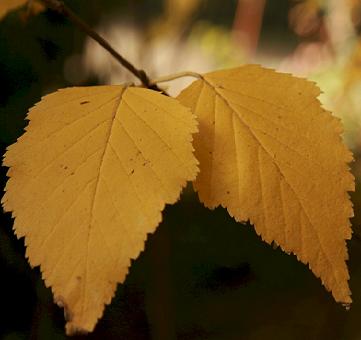 |
||||||||||||||||||||||||||||||
|
Culture: Bitter Cherry adapts well to disturbed or degraded sites. It is used for land reclamation and erosion control. Nursery-grown stock readily establishes on disturbed sites and once established, Bitter Cherry is a good soil stabilizer. |
|||||||||||||||||||||||||||||||
|
In California and Nevada, Bitter Cherry is used for rehabilitating acid mine spoils. At the Leviathan Mine in California, planted Bitter Cherry had a 90 percent survival rate on sites not seeded with grasses after 1 year. By the second year, grasses had established and Bitter Cherry survival dropped to 60 percent of the original planting. Historical and Special interest:
|
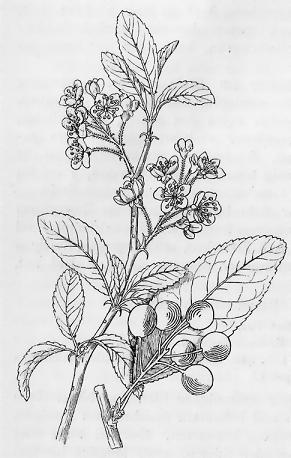 |
||||||||||||||||||||||||||||||
|
Photos We Share!
|
|||||||||||||||||||||||||||||||
|